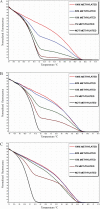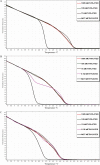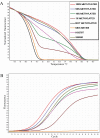Methylation-sensitive high resolution melting (MS-HRM): a new approach for sensitive and high-throughput assessment of methylation
- PMID: 17289753
- PMCID: PMC1874596
- DOI: 10.1093/nar/gkm013
Methylation-sensitive high resolution melting (MS-HRM): a new approach for sensitive and high-throughput assessment of methylation
Abstract
In this article, we show that high resolution melting analysis (HRM) is a sensitive and specific method for the detection of methylation. Methylated DNA and unmethylated DNA acquire different sequences after bisulphite treatment resulting in PCR products with markedly different melting profiles. We used PCR to amplify both methylated and unmethylated sequences and assessed HRM for the determination of the methylation status of the MGMT promoter region. Reconstruction experiments showed that MGMT methylation could be detected at levels as low as 0.1%. Moreover, MS-HRM allows for estimation of the methylation level by comparing the melting profiles of unknown PCR products to the melting profiles of PCR products derived from standards with a known unmethylated to methylated template ratio. We used MS-HRM for the analysis of eight cell lines of known methylation status and a panel of colorectal cancer specimens. The simplicity and high reproducibility of the MS-HRM protocol makes MS-HRM the method of choice for methylation assessment in many diagnostic and research applications.
Figures




References
-
- Gardiner-Garden M, Frommer M. CpG islands in vertebrate genomes. J. Mol. Biol. 1987;196:261–282. - PubMed
-
- Jones PA, Baylin SB. The fundamental role of epigenetic events in cancer. Nat. Rev. Genet. 2002;3:415–428. - PubMed
-
- Esteller M, Corn PG, Baylin SB, Herman JG. A gene hypermethylation profile of human cancer. Cancer Res. 2001;61:3225–3229. - PubMed
-
- Teodoridis JM, Strathdee G, Brown R. Epigenetic silencing mediated by CpG island methylation: potential as a therapeutic target and as a biomarker. Drug Resist. Updat. 2004;7:267–278. - PubMed
Publication types
MeSH terms
Substances
LinkOut - more resources
Full Text Sources
Other Literature Sources
Research Materials

